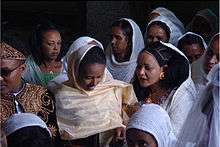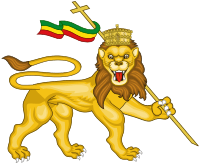Habesha peoples
Habesha peoples (Ge'ez: ሐበሠተ, romanized: Ḥäbäśät or Ḥabäśät; Amharic: ሐበሻ, አበሻ, romanized: Häbäša, 'äbäša; Tigrinya: ሓበሻ, romanized: Ḥabäša; etymologically related to English "Abyssinia" and "Abyssinians" by way of Latin) is a term most frequently employed to refer to Semitic language-speaking Christian peoples of highland Ethiopia and Eritrea. Recently, the term has been applied by some within diasporic communities to refer to all people of Eritrean or Ethiopian origin.
Usage
Historically, the term "Habesha" represented northern Ethiopian Highlands Orthodox Christians, while the Oromos and "Shanqella" ethnic groups, as well as Muslims, were considered outside the periphery.[26][27][28][29] Predominately Muslim ethnic groups in the Eritrean Highlands such as the Tigre have historically opposed the name Habesha; Muslim Tigrinya-speakers are usually referred to as Jeberti people. At the turn of the 20th century, elites of the Solomonic dynasty employed the conversion of various ethnic groups to Orthodox Tewahedo Christianity and the imposition of the Amharic and Tigrinya languages to spread a common Habesha national identity.[30]
Within Ethiopian and Eritrean diasporic populations in North America, some second generation immigrants have adopted the term "Habesha" in a broader sense as a supra-national ethnic identifier inclusive of all Eritreans and Ethiopians. For those who employ the term, it serves as a useful counter to more exclusionary identities. However, this usage is not uncontested: On the one hand, those who grew up in Ethiopia or Eritrea may object to the obscuring of national specificity.[31]:186–188 On the other hand, groups that were subjugated in Ethiopia or Eritrea sometimes find the term offensive.[32]
Etymology
"Habesha" also means “incense gatherer“ in the Mehri language. The Mehra (Mehari) people are the native non-Arab inhabitants of Yemen, Oman, and Socotra. They are the direct descendants of the Sabeans, Himyarites, and to an extent are genetically related to the Cushites and linguistically related to the Ethiosemitic-speaking subgroups of Cushitic Peoples in Sub-Saharan Northeast/Horn of Africa. It is also possible that the Land of Punt covered both the Horn of Africa and Southern Arabia.[33]
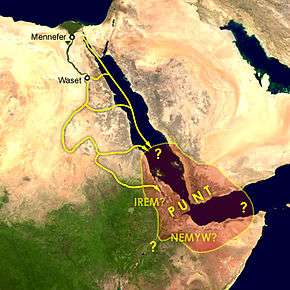
In Arabic, the elevated plateau on the east of the Nile, from which most of the waters of that river are derived, is called Habesh, and its people Habshi.[34] The modern term derives from the vocalized Ge'ez: ሐበሣ Ḥabaśā, first written with a script that did not mark vowels as ሐበሠ ḤBŚ or in "pseudo-Sabaic as ḤBŠTM".[35] The earliest known use of the term dates to the second or third century Sabaean inscription recounting the defeat of the nəgus ("king") GDRT of Aksum and ḤBŠT.[36] The term "Habashat" appears to refer to a group of peoples, rather than a specific ethnicity. A Sabaean inscription describes an alliance between Shamir Yuhahmid of the Himyarite Kingdom and King `DBH of Aksum in the first quarter of the third century. They had lived alongside the Sabaeans, who lived across the Red Sea from them for many centuries:
Shamir of dhū Raydān and Himyar had called in the help of the clans of Habashat for war against the kings of Saba; but Ilmuqah granted... the submission of Shamir of dhū Raydān and the clans of Habashat."[37]
The term "Habesha" was formerly thought by some scholars[35] to be of Arabic descent because the English name Abyssinia comes from the Arabic form. (Arabs used the word Ḥabaš, also the name of an Ottoman province, Habesh Eyalet, comprising parts of modern-day Eritrea).[38] South Arabian expert Eduard Glaser claimed that the hieroglyphic ḫbstjw, used in reference to "a foreign people from the incense-producing regions" (i.e. Punt, located in Eritrea, Northern Somalia, and northeast Ethiopia) used by Queen Hatshepsut c. 1460 BC, was the first usage of the term or somehow connected.
Based on the inscriptions the Aksumites left behind, they did not regard themselves or their territory as Habesha. For them, Habeshas likely meant people who collected incense in South Arabia. Cosmas Indicopleustes, the Greek-speaking Egyptian traveler who visited the Kingdom of Aksum in 525, also made no reference to Habesha.[39][40] According to Dr. Eduard Glaser, an Austrian epigraphist and historian, "Habesha" was originally used to refer to a kingdom in southeastern Yemen located east of the Hadhramaut kingdom in what is now Al Mahrah Governorate. He believed the etymology of Habesha must have derived from the Mehri language, which means “gatherers” (as in gatherers of incense).[40][41] It was not until long after Aksumite kingdom had ended that Gulf Arab travelers and geographers began to describe the Horn region as Al-Habash. The first among these travelers were Al-Mas`udi and Al-Harrani.[42]
Al-Masudi, a tenth-century Gulf Arab traveler to the region, described Habesha country in his geographical work The Meadows of Gold. He wrote that "the chief town of the Habasha is called Kuʿbar, which is a large town and the residence of the Najashi (nagassi; king), whose empire extends to the coasts opposite the Yemen, and possesses such towns as Zayla, Dahlak and Nasi."[42] Al-Harrani, another Gulf Arab traveler, also asserted in 1295 CE that "one of the greatest and best-known towns is Kaʿbar, which is the royal town of the najashi ... Zaylaʿ, a town on the coast of the Red Sea, is a very populous commercial center... . Opposite al-Yaman there is also a big town, which is the seaport from which the Habasha crossed the sea to al-Yaman, and nearby is the island of ʿAql."[42]
By the end of the 8th century, most of the prominent Yemeni kingdoms ended and areas they once controlled were under foreign occupation. Yemen's turbulence, coupled with its ecological volatility likely shifted the international trade of incense from South Arabia to the Horn region. With Habasha originally used to describe people who gathered incense, this term was also given to the region by early Gulf Arab merchants and travelers as a geographic expression that some of the inhabitants of the Horn adopted over time.[40]
When Portuguese missionaries arrived in the interior of what is present-day Ethiopia in the early 16th century CE, they took the altered word Abesha (without the letter “H” beginning) which is used by Ethiopian Amharic speakers of the time and subsequently Latinized it to Abassia, Abassinos, ;Abessina and finally into Abyssinia. This Abyssinia term was widely used as a geographic expression for centuries, even though it was a term not used by the local inhabitants.[40][43]
Habesha and Ethiopian, etymological connection
Following the Hellenic and Biblical traditions, the Monumentum Adulitanum, a third century inscription belonging to the Aksumite Empire, indicates that Aksum's then ruler governed an area which was flanked to the west by the territory of Ethiopia and Sasu. The Aksumite King Ezana would eventually conquer Nubia the following century, and the Aksumites thereafter appropriated the designation "Ethiopians" for their own kingdom. In the Ge'ez version of the Ezana inscription, Aἰθιόποι is equated with the unvocalized Ḥbšt and Ḥbśt (Ḥabashat), and denotes for the first time the highland inhabitants of Aksum. This new demonym would subsequently be rendered as 'ḥbs ('Aḥbāsh) in Sabaic and as Ḥabasha in Arabic.[44]
History

Abyssinian civilization has its roots in the pre-Aksumite culture.[45] An early kingdom to arise was that of D'mt in the 8th century BC. The Kingdom of Aksum, one of the powerful civilizations of the ancient world, was based there from about 150 BC to the mid of 12th century AD. Spreading far beyond the city of Aksum, it molded the one of the earliest cultures of Ethiopia and Eritrea. Architectural remains include finely carved stelae, extensive palaces, and ancient places of worship that are still being used.
Around the time that the Aksumite empire began to decline, the burgeoning religion of Islam made its first inroads in the Abyssinian highlands. During the first Hegira, the companions of prophet Muhammad were received in the Aksumite kingdom. The Sultanate of Showa, established around 896, was one of the oldest local Muslim states. It was centered in the former Shewa province in central Ethiopia. The polity was succeeded by the Sultanate of Ifat around 1285. Ifat was governed from its capital at Zeila in northern Somalia and was the easternmost district of the former Shewa Sultanate.[46]
Antiquity
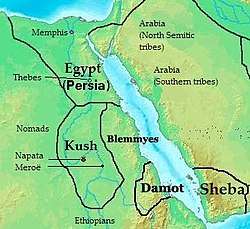
Throughout history, populations in the Horn of Africa had been interacting through migration, trade, warfare and intermarriage. Most people in the region spoke Afroasiatic languages, with the family's Cushitic and Semitic branches predominant.[47] As early as the 3rd millennium BCE, the pre-Aksumites had begun trading along the Red Sea. They mainly traded with Egypt. Earlier trade expeditions were taken by foot along the Nile Valley. The ancient Egyptians' main objective in the Red Sea trade was to acquire myrrh. This was a commodity that the Horn region, which the ancient Egyptians referred to as the Land of Punt, had in abundance. Much of the incense is produced in Somalia to this day.
The Kingdom of Aksum may have been founded as early as 300 BCE. Very little is known of the time period between the mid-1st millennium BCE to the beginning of Aksum's rise around the 1st century CE. It is thought to be a successor kingdom of Dʿmt, a kingdom in the early 1st millennium BC most likely centered at nearby Yeha.[48]
The Kingdom of Aksum was situated in northern Ethiopia and Eritrea, with its capital city in Northern Ethiopia. Axum remained its capital until the 7th century. The kingdom was favorably located near the Blue Nile basin and the Afar depression. The former is rich in gold and the latter in salt: both materials having a highly important use to the Aksumites. Aksum was accessible to the port of Adulis, Eritrea on the coast of the Red Sea. The kingdom traded with Egypt, India, Arabia and the Byzantine Empire. Aksum's "fertile" and "well-watered" location produced enough food for its population. Wild animals included elephants and rhinoceros.[49]
From its capital, Aksum commanded the trade of ivory. It also dominated the trade route in the Red Sea leading to the Gulf of Aden. Its success depended on resourceful techniques, production of coins, steady migrations of Greco-Roman merchants, and ships landing at Adulis. In exchange for Aksum's goods, traders bid many kinds of cloth, jewelry, metals and steel for weapons.
At its peak, Aksum controlled territories as far as southern Egypt, east to the Gulf of Aden, south to the Omo River, and west to the Nubian Kingdom of Meroë. The South Arabian kingdom of the Himyarites and also a portion of western Saudi Arabia was also under the power of Aksum. Their descendants include the present-day ethnic groups known as the Amhara, Tigrayans and Gurage peoples.
Medieval and Early Modern period
After the fall of Aksum due to declining sea trade from fierce competition by Muslims and changing climate, the power base of the kingdom migrated south and shifted its capital to Kubar (near Agew). They moved southwards because, even though the Axumite Kingdom welcomed and protected the companions of Prophet Muhammad to Ethiopia, who came as refugees to escape the persecution of the ruling families of Mecca and earned the friendship and respect of the Prophet. Their friendship deteriorated when South-Arabians invaded the Dahlak islands through the port of Adulis and destroyed it, which was the economic backbone for the prosperous Aksumite Kingdom. Fearing of what recently occurred, Axum shifted its capital near Agew] In the middle of the sixteenth century Adal Sultanate armies led by Harar leader Ahmed Gragn invaded Habesha lands in what is known as the "Conquest of Habasha".[50] Following Gragn invasions the southern part of the Empire was lost to Ethiopia and scattered Habesha like the Gurage people were cut off from the rest of Abyssinia. In the late sixteenth century the nomadic Oromo people penetrated the Habesha plains occupying large territories during the Oromo migrations.[51][52] Abyssinian warlords often competed with each other for dominance of the realm. The Amharas seemed to gain the upper hand with the accession of Yekuno Amlak of Ancient Bete Amhara in 1270, after defeating the Agaw lords of Lasta (in those days a non-Semitic-speaking region of Abyssinia)
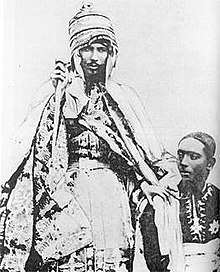
The Gondarian dynasty, which since the 16th century had become the centre of Royal pomp and ceremony of Abyssinia, finally lost its influence as a result of the emergence of powerful regional lords, following the murder of Iyasu I, also known as Iyasu the Great. The decline in the prestige of the dynasty led to the semi-anarchic era of Zemene Mesafint ("Era of the Princes"), in which rival warlords fought for power and the Yejju Oromo እንደራሴ enderases ("regents") had effective control. The emperors were considered to be figureheads. Until a young man named Kassa Haile Giorgis also known as Emperor Tewodros brought end to Zemene Mesafint by defeating all his rivals and took the throne in 1855. The Tigrayans made only a brief return to the throne in the person of Yohannes IV in 1872, whose death in 1889 resulted in the power base shifting back to the dominant Amharic-speaking elite. His successor Menelik II an Emperor of Amhara origin seized power. League of Nations in 1935 reported that after the invasion of Menelik's forces into non Abyssinian lands of Somalis, Harari, Oromo, Sidama, Shanqella etc, the inhabitants were enslaved and heavily taxed by the gebbar system leading to depopulation.[53]

Some scholars consider the Amhara to have been Ethiopia's ruling elite for centuries, represented by the Solomonic line of Emperors ending in Haile Selassie I. Marcos Lemma and other scholars dispute the accuracy of such a statement, arguing that other ethnic groups have always been active in the country's politics. This confusion may largely stem from the mislabeling of all Amharic-speakers as "Amhara", and the fact that many people from other ethnic groups have adopted Amharic names. Another is the claim that most Ethiopians can trace their ancestry to multiple ethnic groups, including the last self-proclaimed emperor Haile Selassie I and his Empress Itege Menen Asfaw of Ambassel.[54]
Origins
Indigenous theory
The Imperial family of Ethiopia (which is currently in exile) claims its origin directly from descent from Solomon and the Queen of Sheba (Ge'ez: ንግሥተ ሣብአ nigiśta Śabʿa), who is named Makeda (Ge'ez: ማክዳ) in the Ethiopian account. The Ethiopian narrative Kebra Negast ("Glory of Kings"), written in 1225 AD[55] contains an account of Makeda and her descendants. Solomon is said in this account to have seduced the Queen, and sired a son by her, who would eventually become Menelik I, the first Emperor of Ethiopia. The tradition that the biblical Queen of Sheba was an ingenuous ruler of Ethiopia who visited King Solomon in Jerusalem is repeated in a 1st-century account by the Roman Jewish historian Josephus. He identified Solomon’s visitor as a queen of Egypt and Ethiopia. There is no primary evidence, archaeological or textual, for the queen in Ethiopia. The impressive ruins at Aksum are a thousand years too late for a queen contemporary with Solomon, based on traditional dates for him of the 10th century BC.[56]
In the past, European scholars including Hiob Ludolf and Carlo Conti Rossini postulated that the ancient communities that evolved into the modern Ethiopian state were formed by a migration across the Red Sea of Semitic-speaking South Arabians around 1000 BC, who intermarried with local non-Semitic-speaking peoples. Both the indigenous languages of Southern Arabia and the Amharic and Tigrinya languages of Ethiopia belong to the large branch of South Semitic languages which in turn is part of the Afro-Asiatic Language Family. Even though the Ethiosemitic languages are classified under the South Semitic languages branch with a Cushitic language substratum, Edward Ullendorff and Carlo Conti Rossini's theory that Ethioemitic-language speakers of the northern Ethiopian Highlands were ancient foreigners from Southwestern Arabia has been disputed by most modern indigenous Horn African scholars like Messay Kebede and Daniel E. Alemu. Ethiopian scholars specializing in Ethiopian Studies such as Messay Kebede and Daniel E. Alemu generally disagree with this theory arguing that the migration was one of reciprocal exchange, if it even occurred at all.
Kebede states the following:
This is not to say that events associated with conquest, conflict and resistance did not occur. No doubt, they must have been frequent. But the crucial difference lies in the propensity to present them, not as the process by which an alien majority imposed its rule but as part of an ongoing struggle of native forces competing for supremacy in the region. The elimination of the alien ruler indigenize Ethiopian history in terms of local actors.[57][58]
Scholars have determined that the ancient Semitic language of Ethiopia was not derived from an Old South Arabian language such as Sabaean. There is evidence of a Semitic-speaking presence in Ethiopia and Eritrea as early as 2000 BC.[59] There is also evidence of ancient Southern Arabian communities in modern-day Ethiopia and Eritrea in certain localities, attested by some archaeological artifacts and ancient Sabaean inscriptions in the old South Arabian alphabet. However, Stuart Munro-Hay points to the existence of an older D'MT kingdom, prior to any Sabaean migration c. 4th or 5th century BC, as well as evidence that Sabaean immigrants had resided in Ethiopia for little more than a few decades at the time of the inscriptions.[60] Archeological evidence has revealed a region called Saba in Northern Ethiopia and Eritrea; it is now referred to as "Ethiopian Saba" to avoid confusion.
Essentially no archaeological evidence supports the story of the Queen of Sheba. "In the 21st century, scholars have largely discounted the longstanding presumption that Sabaean migrants had played a direct role in Ethiopian civilization."[61] Munro-May and related scholars believe that Sabaean influence was minor, limited to a few localities, and disappearing after a few decades or a century. It may have represented a trading colony (tarding post) or military installations in a symbiotic or military alliance between the Sabaens and D`MT.[60]
In the reign of King Ezana, c. early 4th century AD, the term "Ethiopia" is listed as one of the nine regions under his domain, translated in the Greek version of his inscription as Αἰθιοπία Aithiopía. This is the first known use of this term to describe specifically the region known today as Ethiopia (and not Kush or the entire African and Indian region outside of Egypt).[35] The 6th-century author Stephanus of Byzantium later used the term "Αβασηγοί" (i.e. Abasēnoi) to refer to:
an Arabian people living next to the Sabaeans together with the Ḥaḍramites. The region of the Abasēnoi produce[d] myrrh, incense and cotton and they cultivate[d] a plant which yields a purple dye (probably wars, i.e. Fleminga Grahamiana). It lies on a route which leads from Zabīd on the coastal plain to the Ḥimyarite capital Ẓafār.[35]
Abasēnoi was located by Hermann von Wissman as a region in the Jabal Ḥubaysh (Arabic: جَبَل حُبَيْش) mountain in Ibb Governorate,[62] perhaps related in etymology with the ḥbš Semitic root). Other place names in Yemen contain the ḥbš root, such as the Jabal Ḥabaši, whose residents are still called al-Aḥbuš (pl. of Ḥabaš).[63] The location of the Abasēnoi in Yemen may perhaps be explained by remnant Aksumite populations from the 520s conquest by King Kaleb. King Ezana's claims to Sahlen (Saba) and Dhu-Raydan (Himyar) during a time when such control was unlikely may indicate an Aksumite presence or coastal foothold.[64] Traditional scholarship has assumed that the Habashat were a tribe from modern-day Yemen that migrated to Ethiopia and Eritrea. However, the Sabaic inscriptions only use the term ḥbšt to the refer to the Kingdom of Aksum and its inhabitants, especially during the 3rd century, when the ḥbšt (Aksumites) were often at war with the Sabaeans and Himyraites.[63]
South Arabian/Sabaean origin theory
Before the 20th century, the Sabean theory was the most common one explaining the origins of the Habesha. It was first suggested by German orientalist Hiob Ludolf and revived by early 20th-century Italian scholar Conti Rossini. They said that at an early epoch, South Arabian tribes, including one called the "Habashat," emigrated across the Red Sea from Yemen to Eritrea. According to this theory, Sabaeans brought with them South Arabian letters and language, which gradually evolved into the Ge'ez language and Ge'ez script. Linguists have revealed, however, that although its script developed from Epigraphic South Arabian (whose oldest inscriptions are found in Yemen, Ethiopia and Eritrea) used to write the Old South Arabian languages, Ge'ez is descended from a different branch of Semitic, Ethiosemitic or Ethiopic sub-branch.[59]
The large corpus of South Arabian inscriptions does not mention any migration to the west coast of the Red Sea, nor of a tribe called "Habashat." All uses of the term date to the 3rd century AD and later, when they referred to the people of the Kingdom of Aksum.[65][66] In the 21st century, the Sabean theory has largely been abandoned.[67] Edward Ullendorff has asserted that the Tigrayans and the Amhara comprise "Abyssinians proper" and a "Semitic outpost," while Donald N. Levine has argued that this view "neglects the crucial role of non-Semitic elements in Ethiopian culture."[68] Edward Ullendorff and Carlo Conti Rossini's theory that Ethioemitic-language speakers of the northern Ethiopian Highlands were ancient foreigners from Southwestern Arabia that displaced the original peoples of the Horn, has been disputed by most modern indigenous Horn African scholars like Messay Kebede, Daniel E. Alemu, and others. Genetically, culturally, and geographically speaking Habeshas (Abyssinian people) are traditionally Cushitic Peoples.[69][70]
Ethiopia and Sudan are among the main areas linguists suggest were the Afro-Asiatic Urheimat. Recent linguistic studies as to the origin of the Ethiosemitic languages seem to support the DNA findings of immigration from the Arabian Peninsula, with a recent study using Bayesian computational phylogenetic techniques finding that "contemporary Ethiosemitic languages of Africa reflect a single introduction of early Ethiosemitic from southern Arabia approximately 2,800 years ago", and that this single introduction of Ethiosemitic subsequently underwent quick diversification within Ethiopia and Eritrea.[71]
There are many theories regarding the beginning of the Abyssinian civilization. One theory, which is more widely accepted today, locates its origins in the Horn region.[72] At a later period, this culture was exposed to Judaic influence, of which the best-known examples are the Qemant and Ethiopian Jews (or Beta Israel) ethnic groups, but Judaic customs, terminology, and beliefs can be found amongst the dominant culture of the Amhara and Tigrinya.[73] Some scholars have claimed that the Indian alphabets had been used to create the vowel system of the Ge'ez abugida, this claim has not yet been effectively proven.[74]
Culture
The Habesha developed an agricultural society, which most continue, including raising of camels, donkeys, and sheep. They plow using oxen. The Orthodox Church is an integral part of the culture. The church buildings are built on hills. Major celebrations during the year are held around the church, where people gather from villages all around to sing, play games, and observe the unique mass of the church. It includes a procession through the church grounds and environs.
Coffee is a very important ceremonial drink. The "coffee ceremony" is common to the Ethiopians and Eritreans. Beans are roasted on the spot, ground, and brewed, served thick and rich in tiny ceramic cups with no handles. This amount of coffee can be finished in one gulp if drunk cold; but, traditionally it is drunk very slowly as conversation takes place. When the beans are roasted to smoking, they are passed around the table, where the smoke becomes a blessing on the diners. The traditional food served at these meals consists of injera, a spongy flat bread, served with wat, a spicy meat sauce.
Houses in rural areas are built mostly from rock and dirt, the most available resources, with structure provided by timber poles. The houses blend in easily with the natural surroundings. Many times the nearest water source is more than a kilometer away from the house. In addition, people must search for fuel for their fires throughout the surrounding area.
The Habesha people have a rich heritage of music and dance, using drums and stringed instruments tuned to a pentatonic scale. Arts and crafts and secular music are performed mostly by artisans, who are regarded with suspicion. Sacred music is performed and icons are painted only by men trained in monasteries.
Northern Highlander Language and literature
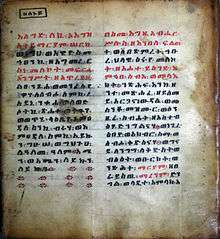
Abyssinians speak languages belonging to the Ethiopian Semitic branch of the Afroasiatic family. Among these tongues is the classical Ge'ez language. The kingdom of Dʿmt wrote proto-Ge'ez in Epigraphic South Arabian as early as the 9th century BCE. Later, an independent script replaced it as early as the 5th century BCE.2
Ge'ez literature is considered to begin with the adoption of Christianity in Ethiopia and Eritrea, as well as the civilization of Axum in the 4th century BCE during the reign of Ezana. While Ge'ez today is extinct and only used for liturgical purposes in the Eritrean Orthodox Tewahedo Church and Ethiopian Orthodox Tewahedo Church. Ge'ez language is ancestral to Tigre and Tigrinya languages.[75]
Some historians in the past have labelled the Ethiopian Semitic languages as the Abyssinian languages.[76] They are mainly spoken by the Amhara, the Tigrayans, the Tigre, the Gurage, the Argobba and the Harari people.[77] In antiquity Ge'ez-speaking people inhabited Axum empire; the ancient Semitic-speaking Gafat inhabited Eastern Damot (East Welega) and Western Shewa; the Galila clan of Aymallal (Sodo) inhabited Southwest Shewa; the Zay inhabited East Shewa; the Harla who are the ancestors of Harari lived in Somalia; and the other ancient Argobba and Harari inhabited Shewa, Ifat, and Adal.[78][79][80][81]
Customs
Throughout history, various European travelers such as Jeronimo Lobo, James Bruce and Mansfield Parkyns visited Abyssinia. Their written accounts about their experiences include observations and descriptions of the Abyssinian customs and manners.
- Cuisine
Habesha cuisine characteristically consists of vegetable and often very spicy meat dishes, usually in the form of wat (also w'et or wot), a thick stew, served atop injera, a large sourdough flatbread,[82] which is about 50 centimeters (20 inches) in diameter and made out of fermented teff flour.[82] People of Ethiopia and Eritrea eat exclusively with their right hands, using pieces of injera to pick up bites of entrées and side dishes.[82]

Fit-fit, or fir-fir, is a common breakfast dish. It is made from shredded injera or kitcha stir-fried with spices or wat. Another popular breakfast food is fatira. The delicacy consists of a large fried pancake made with flour, often with a layer of egg, eaten with honey. Chechebsa (or kita firfir) resembles a pancake covered with berbere and niter kibbeh, or spices, and may be eaten with a spoon. A porridge, genfo is another common breakfast dish. It is usually served in a large bowl with a dug-out made in the middle of the genfo and filled with spiced niter kibbeh.
Wat begins with a large amount of chopped red onion, which is simmered or sauteed in a pot. Once the onions have softened, niter kebbeh (or, in the case of vegan dishes, vegetable oil) is added. Following this, berbere is added to make a spicy keiy wat or keyyih tsebhi. Turmeric is used instead of bebere for a milder alicha wat or both are omitted when making vegetable stews, atkilt wat. Meat such as beef (Amharic: ሥጋ,[83] səga), chicken (Amharic: ዶሮ,[84] doro) or Tigrinya: derho), fish (Amharic: ዓሣ,[85] asa), goat or lamb (Amharic: በግ,[86] beg or Tigrinya: beggi) is also added. Legumes such as split peas (Amharic: ክክ,[87] kək or Tigrinya: kikki) or lentils (Amharic: ምስር,[88] məsər or birsin); or vegetables such as potatoes (Amharic: ድንች,[89] Dənəch), carrots and chard (Amharic: ቆስጣ) are also used instead in vegan dishes.
Another distinctively Habesha dish is kitfo (frequently spelled ketfo). It consists of raw (or rare) beef mince marinated in mitmita (Ge'ez: ሚጥሚጣ mīṭmīṭā, a very spicy chili powder similar to the berbere) and niter kibbeh. Gored gored is very similar to kitfo, but uses cubed rather than ground beef. The Ethiopian Orthodox Church prescribes a number of fasting (tsom Ge'ez: ጾም, ṣōm) periods, including Wednesdays, Fridays, and the entire Lenten season; so Habesha cuisine contains many dishes that are vegan.[90]
- Dress
The habesha kemis is the traditional attire of Habesha women.[91][92] The ankle length dress is usually worn by Ethiopian and Eritrean women at formal events. It is made of chiffon, and typically comes in white, grey or beige shades. Many women also wrap a shawl called a netela around the formal dress.
The netela or netsela is a handmade cloth many Ethiopian women use to cover their head and shoulders when they wear clothing made out of chiffon, especially when attending church. It is made up of two layers of fabric, unlike gabi, which is made out of four. Kuta is the male version.
An Ethiopian or Eritrean suit is the traditional formal wear of Habesha men.[93] It consists of a long sleeve, knee-length shirt, and matching pants. Most shirts are made with a Mandarin, band, or Nehru collar. The suit is made of chiffon, which is a sheer silk or rayon cloth. The netela shawl or a kuta is wrapped around the suit.
Religion
Christianity
The Habesha empire centered in Axum and Adowa was part of the world in which Christianity grew. The arrival of Christianity in Northern Ethiopia and Eritrea happened around the 4th century. The Aksumites, in fact, had been converted to Christianity hundreds of years before most of Europe. Many of their churches were cut into cliffs or from single blocks of stone, as they were in Turkey and in parts of Greece, where Christianity had existed from its earliest years. The church is a central feature of communities and of each family's daily life. Each community has a church with a patron saint.
Ethiopia has often been mentioned in the Bible. A well-known example of this is the story of the Ethiopian eunuch as written in Acts (8: 27): "Then the angel of the Lord said to Philip, Start out and go south to the road that leads down from Jerusalem to Gaza. So he set out and was on his way when he caught sight of an Ethiopian. This man was a eunuch, a high official of the Kandake (Candace) Queen of Ethiopia in charge of all her treasure." The passage continues by describing how Philip helped the Ethiopian understand one passage of Isaiah that the Ethiopian was reading. After the Ethiopian received an explanation of the passage, he requested that Philip baptize him, which Philip obliged. Queen Gersamot Hendeke VII (very similar to Kandake) was the Queen of Ethiopia from the year 42 to 52. The Ethiopian Orthodox Tewahedo Church was founded in the 4th century by Syrian monks. Historically, the Ethiopian Orthodox Tewahedo Church and Eritrean Orthodox Tewahedo Church have had strong ties with the Coptic Orthodox Church of Alexandria, the Coptic Orthodox Church of Alexandria appointing the archbishop for the Eritrean Orthodox Tewahedo Church. They gained independence from the Coptic Orthodox Church of Alexandria in the 1950s, although the Eritrean Orthodox Tewahedo Church has recently reforged the link.
A number of unique beliefs and practices distinguish Ethiopian Orthodox Christianity from other Christian groups; for example, the Ark of the Covenant is very important. Every Ethiopian church has a replica of the Ark. Also, the Ethiopian Church has a larger biblical canon than other churches.
Church services are conducted in Ge´ez, the ancient language of Ethiopia and Eritrea. Ge´ez is no longer a living language, its use now confined to liturgical contexts, occupying a similar place in Eritrean and Ethiopian church life to Latin in the Roman Catholic Church.
Other Ethiopian and Eritrean Orthodox practices include such things as fasting, prescribed prayers, and devotion to saints and angels. A child is never left alone until baptism and cleansing rituals are performed. Boys are baptized forty days after birth, whereas girls are baptized eighty days after birth.
Defrocked priests and deacons commonly function as diviners, who are the main healers. Spirit possession is common, affecting primarily women. Women are also the normal spirit mediums. A debtera is an itinerant lay priest figure trained by the Church as a scribe, cantor, and often as a folk healer, who may also function in roles comparable to a deacon or exorcist. Folklore and legends ascribe the role of magician to the debtera as well.
A small number of Abyssinian Christians adhere to various forms of Pentecostalism or Anabaptism, collectively known as P'ent'ay.
Similarities to Judaism and Islam
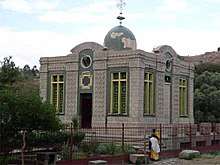
The Ethiopian church places a heavier emphasis on Old Testament teachings than one might find in the Roman Catholic or Protestant churches, and its followers adhere to certain practices that one finds in Orthodox or Conservative Judaism.[94] Ethiopian Christians, like some other Eastern Christians, traditionally follow dietary rules that are similar to Jewish Kashrut, specifically with regard to how an animal is slaughtered. Similarly, pork is prohibited, though unlike Kashrut, Ethiopian cuisine does mix dairy products with meat- which in turn makes it even closer to Islamic dietary laws (see Halal). Women are prohibited from entering the church during their menses; they are also expected to cover their hair with a large scarf (or shash) while in church in keeping with 1 Corinthians 11. As with Orthodox synagogues, men and women are seated separately in the Ethiopian church, with men on the left and women on the right (when facing the altar). However, women covering their heads and separation of the sexes in the Church building officially is common to many Oriental Orthodox, Eastern Orthodox and Catholic Christians and not unique to Judaism. Ethiopian Orthodox worshippers remove their shoes when entering a church, in accordance with Exodus 3:5 (in which Moses, while viewing the burning bush, is commanded to remove his shoes while standing on holy ground). Furthermore, both the Sabbath (Saturday), and the Lord's Day (Sunday) are observed as holy, although more emphasis, because of the Resurrection of Jesus Christ, is laid upon the Holy Sunday.
Islam

Islam in Ethiopia and Eritrea dates to 615. During that year, a group of Muslims were counseled by Muhammad to escape persecution in Mecca and migrate to Abyssinia, which was ruled by, in Muhammad's estimation, a pious Christian king (al-najashi). Muhammad's followers crossed the Red Sea and sought refuge in the Kingdom of Aksum, possibly settling at Negash, a place in present-day Tigray Region. Moreover, Islamic tradition states that Bilal, one of the foremost companions of Muhammad, was from Abyssinia, as were many non-Arab Companions of Muhammad; in fact, Abyssinians were the single largest non-Arab ethnic group who were Muhammad's companions. Among these was Umm Ayman who cared for Muhammad during his infancy, a woman that he referred to as "mother". Abyssinia was thus the earliest home outside of Arabia for the dispersal of the Islamic world faith. One third(34%) of Ethiopia's population are Muslims by last census (2007).
Most of Ethiopia and Eritrea's Muslims are Sunni Muslims, much like the majority of the Muslim world, hence the beliefs and practices of the Muslims of Ethiopia and Eritrea are basically the same: embodied in the Qur'an and the Sunnah. There are also Sufi orders present in Ethiopia. According to the 1994 census of Ethiopia (with similar numbers for the 1984 census), about a third of its population is adherent of Islam and members of the Muslim community can be found throughout the country. Islam in Ethiopia is the predominant religion in the regions of Somali, Afar, Berta, and the section of Oromia east of the Great Rift Valley, as well as in Jimma. Islam in Eritrea is the predominant religion of all the ethnic groups except for the Tigrayan people, the Bilen people, and the Kunama people.
The most important Islamic religious practices, such as the daily ritual prayers (ṣalāt) and fasting (Arabic: صوم ṣawm, Ethiopic ጾም, ṣom – used by local Christians as well) during the holy month of Ramadan, are observed both in urban centers as well as in rural areas, among both settled peoples and nomads. Numerous Ethiopian Muslims perform the pilgrimage to Mecca every year.
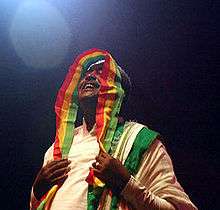
Judaism
Judaism in Ethiopia is believed to date from very ancient times. Precisely what its early history was, however, remains obscure. The now dominant Ethiopian Orthodox Tewahedo Church claims it originated from the visit of the Queen of Sheba to King Solomon back in the 10th century BCE. This visit is mentioned in the Hebrew Scriptures (I Kings 10:1), Sheba was a kingdom that stretched from Ethiopia to the south of the Yemen. Yemen is very close to Ethiopia across the Red Sea, and it has been recorded that modern Ethiopia has been heavily influenced by the ancient Sabean kingdom. Moreover, the details of the queen's visit, including the alleged theft of the Holy Ark as well as Solomon getting her pregnant with a child who established the "Solomonic" lineage in Ethiopia, as given in Christian Ethiopian tradition, were written in the Kebra Nagast the Ethiopian chronicle of its early history. The oldest known existing copies of the book date from as far back as the 13th century. Jewish Ethiopians are mentioned in both the Torah Old Testament as well as the Christian New Testament. It is clear that the Jewish presence in Ethiopia dates back at least 2,500 years.

The Jewish Pre-settlement Theory essentially states that starting around the 8th century BCE until about the 5th century BCE, there was an influx of Jewish settlers both from Egypt & Sudan in the north, and southern Arabia in the east.
The chief Semitic languages of Ethiopia also suggest an antiquity of Judaism in Ethiopia. "There still remains the curious circumstance that a number of Abyssinian words connected with religion—Hell, idol, Easter, purification, alms—are of Hebrew origin. These words must have been derived directly from a Jewish source, for the Abyssinian Church knows the scriptures only in a Ge'ez version made from the Septuagint."[95]
Beta Israel traditions claim that the Ethiopian Jews are descended from the lineage of Moses himself, some of whose children and relatives are said to have separated from the other Children of Israel after the Exodus and gone southwards, or, alternatively or together with this, that they are descended from the tribe of Dan, which fled southwards down the Arabian coastal lands from Judaea at the time of the breakup of the Kingdom of Israel into two kingdoms in the 10th century BCE. (precipitated by the oppressive demands of Rehoboam, King Solomon's heir), or at the time of the destruction of the northern kingdom of Israel in the 8th century BCE. Certainly there was trade as early as the time of King Solomon down along the Red Sea to the Yemen and even as far as India, according to the Bible, and there would, therefore, have been Jewish settlements at various points along the trade routes. There is definite archaeological evidence of Jewish settlements and of their cultural influence on both sides of the Red Sea well at least 2,500 years ago, both along the Arabian coast and in the Yemen, on the eastern side, and along the southern Egyptian and Sudanese coastal regions.
Notable Habeshas
Some notable Habeshas include: Alemayehu Fentaw Weldemariam, Mohamed Hikam Sheikh Abdirahman, Amsalu Aklilu, Mickaël Bethe-Selassié, and Gebre Kristos Desta.
Notes
^ The source texts, RIE 185 and 189, are unvocalized. These vocalizations are from Rainer Voigt and Francis Breyer.[96][97]
- Roughly half of the Eritrean diaspora
References
- Terrazas, Aaron Matteo (June 2007). "Beyond Regional Circularity: The Emergence of an Ethiopian Diaspora". Migration Policy Institute. Retrieved 2011-11-25.
- United States Census Bureau 2009-2013, Detailed Languages Spoken at Home and Ability to Speak English for the Population 5 Years and Over: 2009-2013, USCB, 30 November 2016, <https://www.census.gov/data/tables/2013/demo/2009-2013-lang-tables.html>.
- Israel Central Bureau of Statistics: The Ethiopian Community in Israel
- Amharic-speaking Jews component 85% from Beta Israel; Anbessa Tefera (2007). "Language". Jewish Communities in the Nineteenth and Twentieth Centuries - Ethiopia. Ben-Zvi Institute. p.73 (Hebrew)
- "Istat.it". Statistics Italy.
- "Ethiopian London". BBC. Retrieved 2008-12-06.
- pp, 25 (2015) United Kingdom. Available at: https://www.ethnologue.com/country/GB (Accessed: 30 November 2016).
- "United Kingdom". Ethnologue.com. Retrieved 26 August 2017.
- "Anzahl der Ausländer in Deutschland nach Herkunftsland". Das Statistik Portal.
- Amharas are estimated to be the largest ethnic group of estimated 20.000 Ethiopian Germans|https://www.giz.de/fachexpertise/downloads/gtz2009-en-ethiopian-diaspora.pdf Archived 2018-10-04 at the Wayback Machine
- "Foreign-born persons by country of birth, age, sex and year". Statistics Sweden.
- "Immigrants and Norwegian-born to immigrant parents". Statistics Norway.
- Canada, Government of Canada, Statistics (2013-02-05). "2011 Census of Canada: Topic-based tabulations – Detailed Mother Tongue (232), Knowledge of Official Languages (5), Age Groups (17A) and Sex (3) for the Population Excluding Institutional Residents of Canada and Forward Sortation Areas, 2011 Census". 12.statcan.gc.ca. Retrieved 26 August 2017.
- Statistics Canada, 2011 Census of Population, Statistics Canada Catalogue no. 98-314-XCB2011032
- Anon, 2016. 2011 Census of Canada: Topic-based tabulations | Detailed Mother Tongue (232), Knowledge of Official Languages (5), Age Groups (17A) and Sex (3) for the Population Excluding Institutional Residents of Canada and Forward Sortation Areas, 2011 Census. [online] Www12.statcan.gc.ca. Available at: <http://www12.statcan.gc.ca/census-recensement/2011/dp-pd/tbt-tt/Rp-eng.cfm?LANG=E&APATH=3&DETAIL=0&DIM=0&FL=A&FREE=0&GC=0&GID=0&GK=0&GRP=1&PID=103001&PRID=10&PTYPE=101955&S=0&SHOWALL=0&SUB=0&Temporal=2011&THEME=90&VID=0&VNAMEE=&VNAMEF=> [Accessed 2 Dec. 2016].
- Immigrant languages in Canada. 2016. Immigrant languages in Canada. [ONLINE] Available at: https://www12.statcan.gc.ca/census-recensement/2011/as-sa/98-314-x/98-314-x2011003_2-eng.cfm. [Accessed 13 December 2016].
- "Population by migration background". Statistics Netherlands.
- "Population by country of origin". Statistics Denmark.
- "The People of Australia Statistics from the 2011 Census, Cat. no. 2901.0, ABS" (PDF). Australian Bureau of Statistics. 2014. Archived from the original (PDF) on 2017-04-17. Retrieved 2017-08-26.
- Australian Bureau of Statistics 2014, The People of Australia Statistics from the 2011 Census, Cat. no. 2901.0, ABS, 30 November 2016, <https://www.border.gov.au/ReportsandPublications/Documents/research/people-australia-2013-statistics.pdf Archived 2017-04-17 at the Wayback Machine>.
- Australian Bureau of Statistics 2014, The People of Australia Statistics from the 2011 Census, Cat. no. 2901.0, ABS, 30 November 2016, Archived 17 April 2017 at the Wayback Machine
- "Archived copy". Archived from the original on 2018-06-26. Retrieved 2019-05-02.CS1 maint: archived copy as title (link)
- Trimingham, J. (2013). Islam in Ethiopia. Routledge. p. 23. ISBN 978-1136970221. Retrieved 19 September 2016.
- "Religious Composition by Country, 2010-2050". Pew Research Center. Retrieved 26 October 2017.
- 2007 Ethiopian census, first draft, Ethiopian Central Statistical Agency (accessed 6 May 2009)
- Makki, Fouad (2006). Eritrea between empires: Nationalism and the anti-colonial imagination, 1890–1991 (PhD). SUNY Binghamton. pp. 342–345.
- Epple, Susanne. Creating and Crossing Boundaries in Ethiopia: Dynamics of Social Categorization and Differentiation. LIT Verlag Münster. p. 194.
- Historical Dictionary of Eritrea. Scarecrow Press. p. 279.
- Making Citizens in Africa: Ethnicity, Gender, and National Identity in Ethiopia. Cambridge University Press. p. 54.
- Jalata, Asafa. Cultural Capital and Prospects for Democracy in Botswana and Ethiopia. Routledge.
- Habecker, Shelly (2012). "Not black, but Habasha: Ethiopian and Eritrean immigrants in American society". Ethnic and Racial Studies. 35 (7): 1200–1219.
- Dimitri Meeks – Chapter 4 – "Locating Punt" from the book Mysterious Lands", by David B. O'Connor and Stephen Quirke.
- First Annual Report of the Trustees of Donations for Education in Liberia. Annual Meeting. Boston: T.R. Marvin. January 1851. p. 32.
In Arabic, the elevated plateau on the east of the Nile, from which most of the waters of that river are derived, is called Habesh, and its people Habshi. The Latin writers transformed Habesh into Abassia, which in time became corrupted into Abyssinia, and restricted, in its meaning, to the northern part of the plateau.
Published in Edward Royall Tyler; William Lathrop Kingsley; George Park Fisher; Timothy Dwight, eds. (1851). "Literary Notices". New Englander and Yale Review. IX: 462. Retrieved 14 August 2015. - Uhlig, Siegbert, ed. Encyclopaedia Aethiopica: D-Ha. Wiesbaden: Harrassowitz Verlag, 2005. p. 948.
- Munro-Hay, Stuart (1991). Aksum: A Civilization of Late Antiquity. Edinburgh University Press. p. 39. ISBN 978-0748601066.
- Munro-Hay, Aksum, p. 66.
- Munro-Hay, Aksum, p. 19.
- Pankhurst, Estelle Sylvia (1955). Ethiopia: A Cultural History. Lalibela House.CS1 maint: ref=harv (link), p. 22.
- "The True Origin of Habesha" Archived 2015-04-15 at the Wayback Machine, eriswiss.com Retrieved 2015-04-10
- "The Academy, Volume 48 - Google Books": J. Murray, 1895. p. 415.
- "An African Civilisation of Late Antiquity" Archived 2016-03-04 at the Wayback Machine: Stuart Munro-Hay, 1991. p. 90
- The Penny Cyclopaedia of the Society for the Difussion of Useful Knowledge. Charles Knight. 1833.CS1 maint: ref=harv (link), p. 52.
- Hatke, George (2013). Aksum and Nubia: Warfare, Commerce, and Political Fictions in Ancient Northeast Africa. NYU Press. pp. 52–53. ISBN 978-0-8147-6066-6.
- Fattovich, Rodolfo (1975). Pre-Aksumite Civilization of Ethiopia. Proceedings of the Seminar for Arabian Studies, Volumes 5-7. p. 73. Retrieved 6 February 2017.
- Katpeijns, Lidwien (2000). The History of Islam in Africa - Ethiopia and the Horn of Africa. Ohio University Press. p. 228. ISBN 978-0821444610. Retrieved 20 October 2016.
- Munro-Hay, Aksum, p. 62
- Munro-Hay, Aksum, p. 4
- Pankhurst 1998, pp. 22-3
- Cook, David. Martyrdom in Islam. Cambridge University Press. p. 91.
- "Ethiopia, a Country Study". U.S. Government Printing Office. 28: 13–14.
- Reid, Richard. Frontiers of Violence in North-East Africa: Genealogies of Conflict Since C.1800. Oxford University Press. p. 30.
- Ethiopia: land of slavery & brutality (PDF). League of Nations. 1935. pp. 2–5.
- Emperor Haile Selassie I, Part 1 Archived 2012-01-19 at the Wayback Machine, Official Ethiopian Monarchy Website.
- Hubbard, David Allen (1956). The Literary Sources of the "Kebra Nagast". St Andrews. p. 358.
- "The Queen Of Sheba" Archived 2012-10-29 at the Wayback Machine, BBC History
- Kebede, Messay (2003). "Eurocentrism and Ethiopian Historiography: Deconstructing Semitization". University of Dayton-Department of Philosophy. International Journal of Ethiopian Studies. Tsehai Publishers. 1: 1–19 – via JSTOR.
- Alemu, Daniel E. (2007). "Re-imagining the Horn". African Renaissance. 4 (1): 56–64 – via Ingenta.
- Uhlig, Siegbert, ed. Encyclopaedia Aethiopica, "Ge'ez" (Wiesbaden: Harrassowitz Verlag, 2005), p. 732.
- Munro-Hay, Aksum, p. 57.
- Pankhurst, Richard K. P. (January 17, 2003). "Let's Look Across the Red Sea I". Addis Tribune. Archived from the original on August 30, 2006.
- Jabal Ḩubaysh, Geoview.info, retrieved 2018-01-11
- Uhlig, Siegbert, ed. Encyclopaedia Aethiopica;: D-Ha. Wiesbaden: Harrassowitz Verlag, 2005. pp. 949.
- Munro-Hay. Aksum, p. 72.
- Curtis, Matthew C. (2002). "Ancient Interaction across the Southern Red Sea: cultural exchange and complex societies in the 1st millennium BC". Red Sea Trade and Travel. Oxford: Archaeopress. p. 60. ISBN 978-1841716220.
- Irvine, A. K. (1965). "On the identity of Habashat in the South Arabian inscriptions". Journal of Semitic Studies. 10 (2): 178–196. doi:10.1093/jss/10.2.178.
- Stefan Weninger. "Ḥäbäshat", Encyclopaedia Aethiopica: D-Ha.
- Levine, Donald (May 2000). Greater Ethiopia: The Evolution of a Multiethnic Society. University of Chicago Press. p. 18. ISBN 9780226475615. Retrieved 28 December 2016.
- Kebede, Messay (2003). "Eurocentrism and Ethiopian Historiography: Deconstructing Semitization". University of Dayton-Department of Philosophy. International Journal of Ethiopian Studies. Tsehai Publishers. 1: 1–19 – via JSTOR.
- Alemu, Daniel E. (2007). "Re-imagining the Horn". African Renaissance. 4.1: 56–64 – via Ingenta.
- Kitchen, Andrew; Ehret, Christopher; Assefa, Shiferaw; Mulligan, Connie J. (2009). "Bayesian phylogenetic analysis of Semitic languages identifies an Early Bronze Age origin of Semitic in the Near East". Proceedings of the Royal Society B: Biological Sciences. 276 (1668): 2703–2710. doi:10.1098/rspb.2009.0408. PMC 2839953. PMID 19403539. Bayesian phylogenetic analysis of Semitic languages identifies an Early Bronze Age origin of Semitic in the Near East.
- Stuart Munro-Hay, Aksum: An African Civilisation of Late Antiquity. Edinburgh: University Press, 1991, pp. 57f.
- For an overview of this influence see Ullendorff, Ethiopia and the Bible, pp. 73ff.
- Henze, Paul B. (2000). Layers of Time, A History of Ethiopia. New York: Palgrave. p. 37. ISBN 978-0-312-22719-7.
- "Ge'ez language". Encyclopedia Britannica.
-
- Metalogicon, Volumes 12-13. L.E.R. 1999. p. 36.
*Ullendorf, Edward (1955). The Semitic Languages of Ethiopia: A Comparative Phonology. Taylor's (Foreign) Press. p. 45.
*Dʹi︠a︡konov, Igorʹ Mikhaĭlovich (1965). Semito-Hamitic Languages: An Essay in Classification. Nauka, Central Department of Oriental Literature. p. 12.
- Metalogicon, Volumes 12-13. L.E.R. 1999. p. 36.
- Igorʹ Mikhaĭlovich Dʹi︠a︡konov Semito-Hamitic Languages: An Essay in Classification - Google Books": Nauka, Central Department of Oriental Literature, (1965) pp 12
- Michael Kleiner (2004). Verena Böll (ed.). Studia Aethiopica - Were the Gambo a Gafat Group? Deliberations on a Finer Point of Ethiopian Ethnohistory. Otto Harrassowitz Verlag. p. 154. ISBN 978-3447048910. Retrieved 29 October 2016.
- Robert Hetzron Ethiopian Semitic: Studies in Classification - Internet Archive": Manchester University Press, 1972 p. 6.
- Nehemia Levtzion, Randall Pouwels The History of Islam in Africa - Google Books" Archived 2017-01-16 at the Wayback Machine Ohio University Press, 2000. p. 228.
- George Wynn Brereton Huntingford The Historical Geography of Ethiopia: From the First Century Ad to 1704 - Google Books" British Academy, 1989. p. 78.
- Javins, Marie. "Eating and Drinking in Ethiopia." Archived January 31, 2013, at the Wayback Machine Gonomad.com Archived 2014-05-28 at the Wayback Machine. Accessed July 2011.
- Selam Soft, "ሥጋ" Archived 2013-06-28 at Archive.today, Amharic-English Dictionary', 4/30/13
- Selam Soft, "ዶሮ" , Amharic-English Dictionary', 4/30/13
- Selam Soft, "ዓሣ" Archived 2013-06-28 at Archive.today, Amharic-English Dictionary', 4/30/13
- Selam Soft, "'በግ Archived 2013-06-28 at Archive.today, Amharic-English Dictionary', 4/30/13
- Selam Soft, "ክክ" Archived 2013-06-28 at Archive.today, Amharic-English Dictionary', 4/30/13
- Selam Soft, "ምስር" Archived 2013-06-28 at Archive.today, Amharic-English Dictionary', 4/30/13
- Selam Soft, "ድንች" Archived 2013-08-03 at Archive.today, Amharic-English Dictionary', 4/30/13
- Paul B. Henze, Layers of Time: a history of Ethiopia (New York: Palgrave, 2000), p. 12 and note
- Travel & Leisure Volume 36 2006 "A woman with her hair in tight braids and wearing habesha kemis — a white ankle-length dress with intricate embroidery — came around to each of us with a silver kettle of warm water and a silver basin for washing our hands."
- Lisa L. Schoonover, 2012, The Indigo Butterfly, p.114
- Janet Jaymes Dirty Laundry: a memoir. 2006, p. 89.
- http://www.kebranegast.com Archived 2011-11-10 at the Wayback Machine Kebra Negast
- Monroe, Elizabeth (2001). The History of Ethiopia. London: Simon Publications. p. 40. ISBN 978-1-931541-62-6.
- Voigt, Rainer (2016). "Language, Script And Society In The Axumite Kingdom". Ityop̣is. Extra Issue II: 59–80.
- Breyer, Francis (2016). "The Ancient Egyptian Etymology of Ḥabašāt "Abessinia"". Ityop̣is. Extra Issue II: 8–18.

- Pankhurst, Dr. Richard. "History of Northern Ethiopia - and the Establishment of the Italian Colony or Eritrea". Civic Webs Virtual Library. Archived from the original on March 23, 2005. Retrieved March 25, 2005.

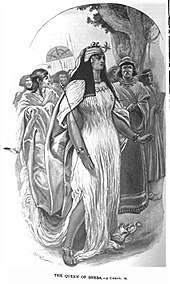
.jpg)
